Lanhua Li
Learning Joint Source-Channel Encoding in IRS-assisted Multi-User Semantic Communications
Apr 10, 2025Abstract:In this paper, we investigate a joint source-channel encoding (JSCE) scheme in an intelligent reflecting surface (IRS)-assisted multi-user semantic communication system. Semantic encoding not only compresses redundant information, but also enhances information orthogonality in a semantic feature space. Meanwhile, the IRS can adjust the spatial orthogonality, enabling concurrent multi-user semantic communication in densely deployed wireless networks to improve spectrum efficiency. We aim to maximize the users' semantic throughput by jointly optimizing the users' scheduling, the IRS's passive beamforming, and the semantic encoding strategies. To tackle this non-convex problem, we propose an explainable deep neural network-driven deep reinforcement learning (XD-DRL) framework. Specifically, we employ a deep neural network (DNN) to serve as a joint source-channel semantic encoder, enabling transmitters to extract semantic features from raw images. By leveraging structural similarity, we assign some DNN weight coefficients as the IRS's phase shifts, allowing simultaneous optimization of IRS's passive beamforming and DNN training. Given the IRS's passive beamforming and semantic encoding strategies, user scheduling is optimized using the DRL method. Numerical results validate that our JSCE scheme achieves superior semantic throughput compared to the conventional schemes and efficiently reduces the semantic encoder's mode size in multi-user scenarios.
Exploiting NOMA Transmissions in Multi-UAV-assisted Wireless Networks: From Aerial-RIS to Mode-switching UAVs
Dec 29, 2024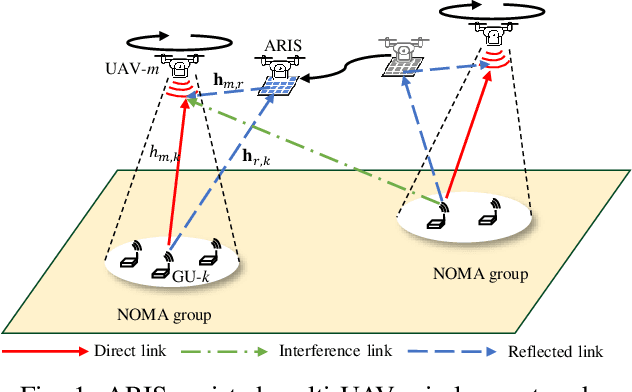
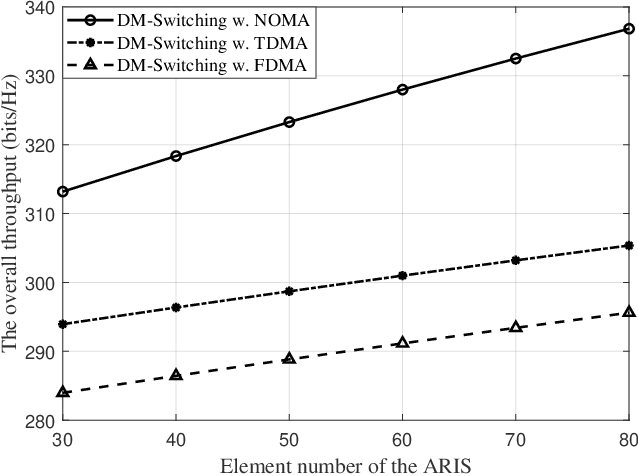
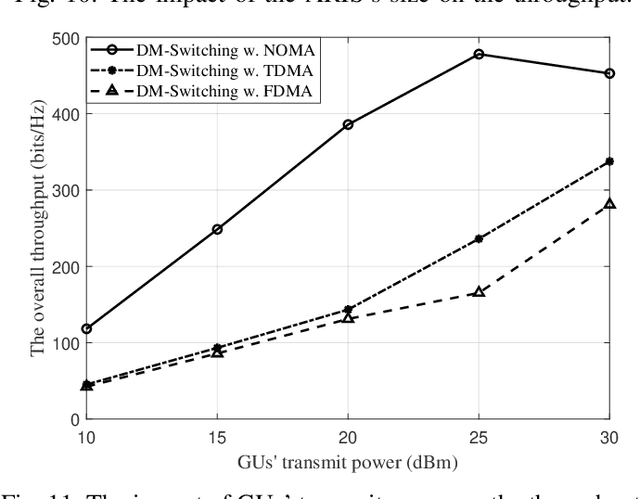
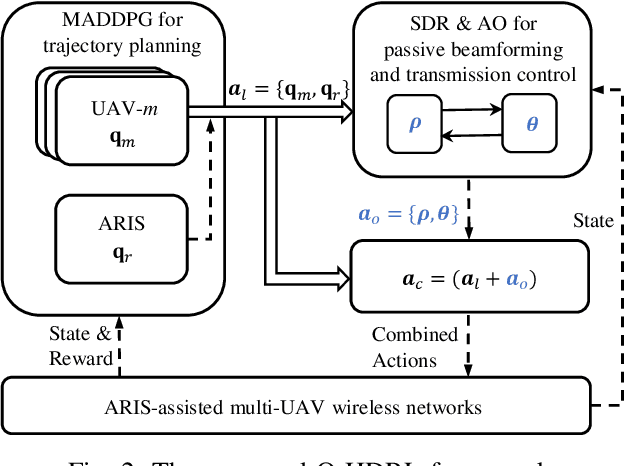
Abstract:In this paper, we consider an aerial reconfigurable intelligent surface (ARIS)-assisted wireless network, where multiple unmanned aerial vehicles (UAVs) collect data from ground users (GUs) by using the non-orthogonal multiple access (NOMA) method. The ARIS provides enhanced channel controllability to improve the NOMA transmissions and reduce the co-channel interference among UAVs. We also propose a novel dual-mode switching scheme, where each UAV equipped with both an ARIS and a radio frequency (RF) transceiver can adaptively perform passive reflection or active transmission. We aim to maximize the overall network throughput by jointly optimizing the UAVs' trajectory planning and operating modes, the ARIS's passive beamforming, and the GUs' transmission control strategies. We propose an optimization-driven hierarchical deep reinforcement learning (O-HDRL) method to decompose it into a series of subproblems. Specifically, the multi-agent deep deterministic policy gradient (MADDPG) adjusts the UAVs' trajectory planning and mode switching strategies, while the passive beamforming and transmission control strategies are tackled by the optimization methods. Numerical results reveal that the O-HDRL efficiently improves the learning stability and reward performance compared to the benchmark methods. Meanwhile, the dual-mode switching scheme is verified to achieve a higher throughput performance compared to the fixed ARIS scheme.
Contextual Bandits with Non-Stationary Correlated Rewards for User Association in MmWave Vehicular Networks
Oct 08, 2024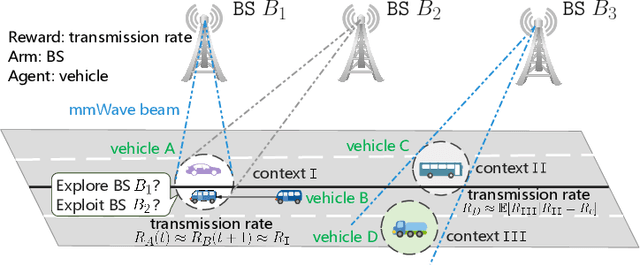

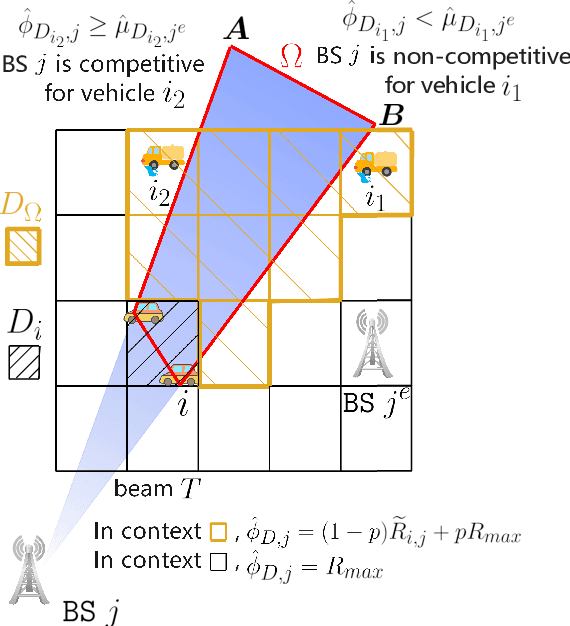

Abstract:Millimeter wave (mmWave) communication has emerged as a propelling technology in vehicular communication. Usually, an appropriate decision on user association requires timely channel information between vehicles and base stations (BSs), which is challenging given a fast-fading mmWave vehicular channel. In this paper, relying solely on learning transmission rate, we propose a low-complexity semi-distributed contextual correlated upper confidence bound (SD-CC-UCB) algorithm to establish an up-to-date user association without explicit measurement of channel state information (CSI). Under a contextual multi-arm bandits framework, SD-CC-UCB learns and predicts the transmission rate given the location and velocity of the vehicle, which can adequately capture the intricate channel condition for a prompt decision on user association. Further, SD-CC-UCB efficiently identifies the set of candidate BSs which probably support supreme transmission rate by leveraging the correlated distributions of transmission rates on different locations. To further refine the learning transmission rate over the link to candidate BSs, each vehicle deploys the Thompson Sampling algorithm by taking the interference among vehicles and handover overhead into consideration. Numerical results show that our proposed algorithm achieves the network throughput within 100%-103% of a benchmark algorithm which requires perfect instantaneous CSI, demonstrating the effectiveness of SD-CC-UCB in vehicular communications.
Matching-Driven Deep Reinforcement Learning for Energy-Efficient Transmission Parameter Allocation in Multi-Gateway LoRa Networks
Jul 18, 2024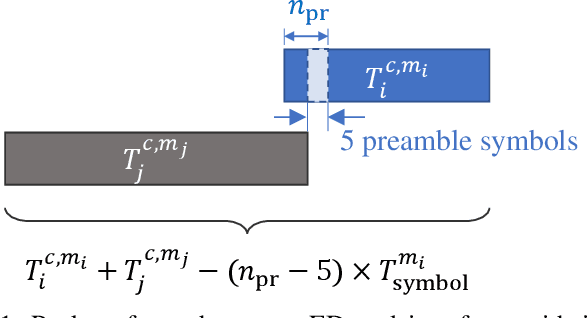
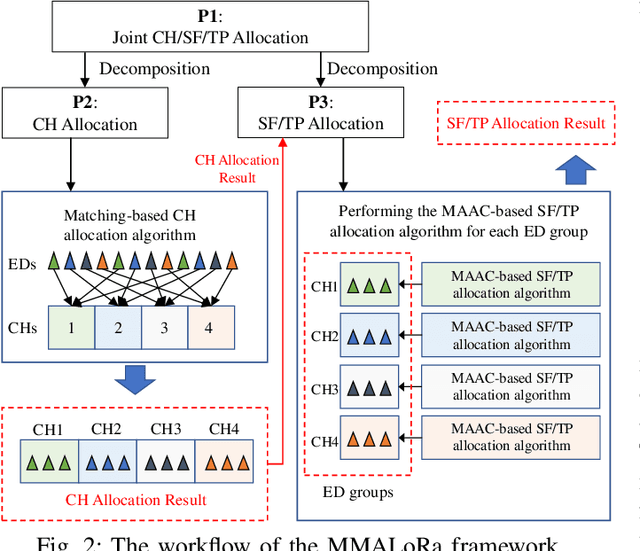
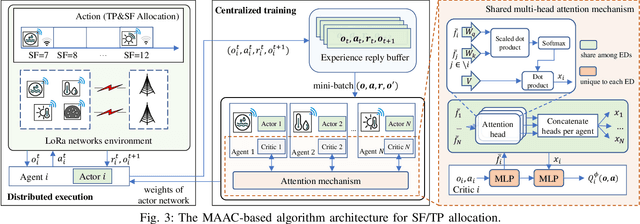
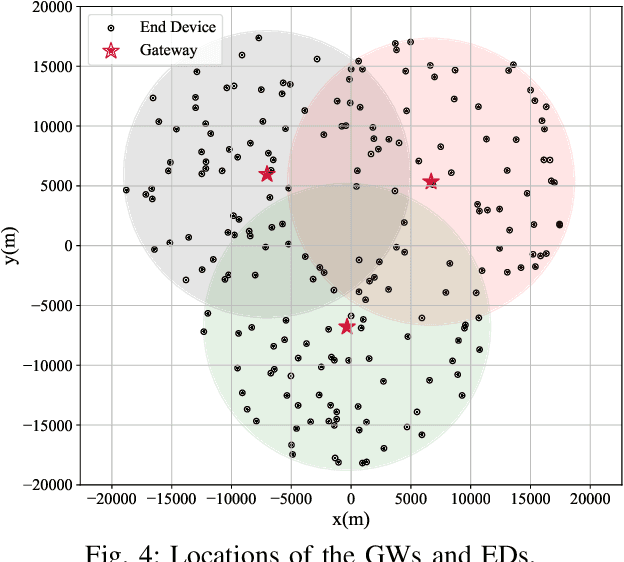
Abstract:Long-range (LoRa) communication technology, distinguished by its low power consumption and long communication range, is widely used in the Internet of Things. Nevertheless, the LoRa MAC layer adopts pure ALOHA for medium access control, which may suffer from severe packet collisions as the network scale expands, consequently reducing the system energy efficiency (EE). To address this issue, it is critical to carefully allocate transmission parameters such as the channel (CH), transmission power (TP) and spreading factor (SF) to each end device (ED). Owing to the low duty cycle and sporadic traffic of LoRa networks, evaluating the system EE under various parameter settings proves to be time-consuming. Consequently, we propose an analytical model aimed at calculating the system EE while fully considering the impact of multiple gateways, duty cycling, quasi-orthogonal SFs and capture effects. On this basis, we investigate a joint CH, SF and TP allocation problem, with the objective of optimizing the system EE for uplink transmissions. Due to the NP-hard complexity of the problem, the optimization problem is decomposed into two subproblems: CH assignment and SF/TP assignment. First, a matching-based algorithm is introduced to address the CH assignment subproblem. Then, an attention-based multiagent reinforcement learning technique is employed to address the SF/TP assignment subproblem for EDs allocated to the same CH, which reduces the number of learning agents to achieve fast convergence. The simulation outcomes indicate that the proposed approach converges quickly under various parameter settings and obtains significantly better system EE than baseline algorithms.
 Add to Chrome
Add to Chrome Add to Firefox
Add to Firefox Add to Edge
Add to Edge